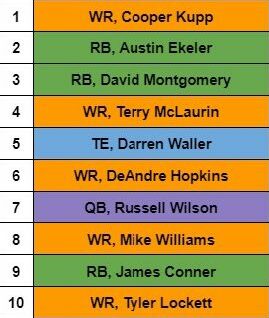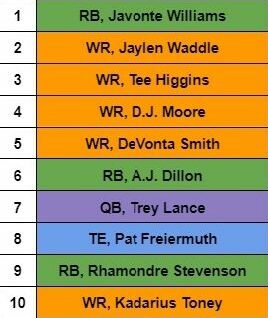With the NFL offseason already rolling, it’s officially the start of dynasty season. For those that are obsessed with fantasy football, dynasty leagues can hold off your football cravings as free agency and the draft will mean much more to managers rather than the regular season being the sole focus.
The dynasty format is steadily increasing in popularity year after year and plenty of first-time players will be joining a league of their own. Dynasty is a much different experience than your typical redraft league and it can be much more enjoyable with a group of people who are engaged in year-round NFL developments.
Being a new player who is already ahead of the curve can be one of the greatest advantages when joining a new dynasty league. With so many new players jumping into the space, here are some different pieces of strategy for your dynasty startup draft.
Featured Promo: Get any full-season NFL Premium Pass for 50% off and win big in 2022. Exclusive access to our Premium articles, 15 lineup tools, new Team Sync platform, Lineup Optimizer, Premium DFS tools and cheat sheets, and much more! Sign Up Now!
Draft for Value
The main aspect of a dynasty startup draft that needs to be remembered is to draft for value rather than necessity. Drafting for value entails selecting the best available players that fall to your draft selection. When you’re in the middle of a draft, the instincts of a typical redraft league might kick in and tell you to pick players that will keep positions balanced.
That will only hurt your roster in the long run. Stacking a roster full of players that hold value will create a deep team that has more opportunities to make moves for star players. This will bring you ahead of your league-mates and elevate your team into a sustained window for championship contention.
To put this situation in context, drafting for positional balance is like reaching for James Conner over Chase Claypool because you want to keep a balance between running backs and wide receivers on your roster. On one end, you’re keeping your roster from becoming too wide receiver-centric, but on the other, you’re doing your entire roster a disservice.
Selecting a player like Conner in that situation is a mistake as he's nearing 27 and could move into irrelevance in the coming years. Chase Claypool should only be rising in value due to his positional longevity as a wide receiver and his young age (nearing 24 years old). Rather than reaching on a guy to fill a supposed roster hole, grab the guy that you know has a higher chance of holding their value.
Pay attention to the direction your early rounds take
The first few rounds of a dynasty startup can dictate a lot about the direction you should be taking your draft. When you’re picking these roster anchors that are supposed to be heavy contributors to your team, recognizing their characteristics can give you a clear idea of what path to go down. The age and current production level of these early selections will play a large role in whether you try and win now or build a young core.
Note: The two strategies below can easily be combined to form a hybrid roster of young and old players. Yet, having a specific strategy on hand can provide some peace of mind when you’re lost in a particular round of a startup draft.
Win-Now Strategy
When you’re entering a dynasty startup draft, most people will have the goal of building a team that is full of young talent and two years away from becoming a juggernaut. However, that's not how it pans out for everyone. Sometimes the players that fall to you will be set in the middle or late years of their prime which will shift your roster into “win now” mode.
Say you're drafting (1 QB league to simplify things) and you land Austin Ekeler and Cooper Kupp in your first two rounds. Your thought going into round three should be that this roster is heading into “win-now” territory. So, for the remaining rounds of your draft, the strategy you take should be in targeting players who are relevant at the moment and have a decent shot at putting up top tier numbers in the next couple of years.
While it might be fun to take a shot on a player like Elijah Moore to see if he can develop in the future, your early picks are currently at the top of their game and older for their positions. Your draft strategy should be surrounding those anchors with other players at their peak performance as well.
Not every draft is the same but here is an example of the types of players that should be targeted if you head into a “win now” draft strategy.

With this lineup above, the average age of the players you drafted in the first 10 rounds will be 28.6. While this will provide a shorter window for success, you will be in the driver's seat with a great chance at hoisting one or two league championships in the first few years.
Young Core Strategy
On the opposite spectrum, you might fall into the strategy that most players think of when constructing a dynasty roster. Building a young core that holds a team together can be a great feeling for anybody starting out in a dynasty league. This kind of strategy can be hard to pull off as most managers will enter the draft with the same mentality as you. If you are able to pull it off though, your team can be a threat for years to come without you having to make too many major roster adjustments.
Let’s say you bring in Javonte Williams and Jaylen Waddle with your first two selections. Then your strategy should be collecting young talent that will develop into future stars. Of course, you don’t have to stick to that method 100% of the time. You can take shots on players that don’t fit the mold but it would be wise to build your roster to match the characteristics of your early draft picks.
For example, selecting a player like DeAndre Hopkins when your team is full of second and third year players doesn’t make much sense. You aren’t looking for a title for the first couple of years and Hopkins seems to be in his late prime at the age of 30. When the rest of your team has developed into upper-level talent, Hopkins will be on the downturn and won’t fit the mold.
Here is an example of how the first 10 rounds of your draft could go if you choose to follow this path.

The 10 players above will have a combined age of 23.2 at the start of the 2022 season. These players aren’t supposed to launch you into championship contention in your league’s inaugural season. However, if they elevate themselves into the higher tier of fantasy options, your team should be one of the more dangerous rosters for the next several years.
One QB or Superflex?
Not every dynasty league is the same and one of the main differences that leagues have is whether to incorporate a Superflex slot into starting lineups. Superflex is a very interesting piece of dynasty leagues as it allows managers the option of starting two quarterbacks rather than your typical one.
While some leagues might want to stick with the simple one quarterback system, Superflex increases the importance of the position as having two elite quarterbacks in a starting lineup is a massive advantage. Including a Superflex spot increases the value of star quarterbacks which can make a dynasty league more like the actual NFL and how teams value quarterbacks. Whether your league opts to go with Superflex or if they want to keep it simple with one quarterback, the two roster settings can drastically alter a startup draft.
One-QB Strategy
The one quarterback strategy in dynasty is pretty much the same as a redraft league other than some differences in individual player value based on age. Loading up on talent at running back and wide receiver is usually the best way to go while the elite quarterbacks tend to go from rounds 3-6. Quarterback isn’t necessarily an afterthought in the one QB format, but you’d be better off stacking talent at other positions and waiting to draft one until later. So, instead of reaching for a star quarterback early, it’d be wise to wait and build up other skill positions.
Superflex Strategy
The success of a dynasty Superflex draft hinges heavily on the quarterbacks a manager is able to select. In most Superflex drafts, the upper echelon of quarterbacks will certainly dominate the early rounds of the startup. To someone that isn’t familiar with Superflex drafts, it can be a little daunting to see 10-12 quarterbacks come off the board in the first three rounds. That’s why it is incredibly important to familiarize yourself with the format and secure your signal-callers. Rather than leaving quarterback for the later rounds of a draft, a manager’s top priority should be in rostering at least one good quarterback.
Below is a Superflex mock that shows how quick quarterbacks will fly off the board. In just four rounds, half of the NFL's starting quarterbacks are already unavailable.

Keep in mind that an elite option might not always fall to you. Sometimes you have to settle for quarterbacks that aren’t game breakers but they’re in stable situations. Some examples of this would be players like Ryan Tannehill or Derek Carr. They don’t usually flash with massive performances but you know that they’re going to be starting for their team every week. Don’t be uncomfortable with reaching for a strong quarterback. The well can dry up very quickly and the last thing you want is to be stuck with a player like Carson Wentz as your number one starter.
 RADIO
RADIO






















